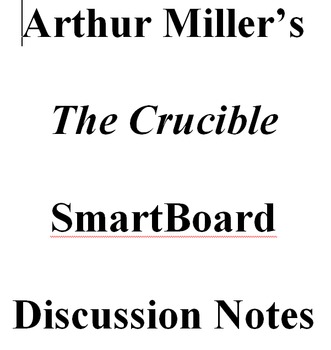The Crucible SmartBoard Discussion Notes
Scott Johnson
6 Followers
Grade Levels
10th - 12th
Subjects
Resource Type
Standards
CCSSRL.9-10.1
CCSSRL.9-10.2
CCSSRL.9-10.3
CCSSRL.9-10.5
CCSSRL.11-12.1
Formats Included
- NOTEBOOK (SMARTboard) File
Pages
46 pages
Scott Johnson
6 Followers
Description
Arthur Miller’s The Crucible is a complex and powerful work with many characters and ideas. These SmartBoard notes help students understand the play in many ways:
• Ensuring basic plot and character understanding
• Adding relevant cultural context to the time of the Puritans
• Challenging students to make inferences
• Encouraging students to use text to support their ideas
On many slides, a key question, whether plot point, character motivation, or thematic inquiry, is posed, and a quote from the text is minimized, allowing for the students to first share their own responses, and then for the instructor to share a supporting passage from the text.
Students respond to The Crucible with passion, outrage, and appreciation. These discussion points will contribute to listening and speaking skills in your classroom.
• Ensuring basic plot and character understanding
• Adding relevant cultural context to the time of the Puritans
• Challenging students to make inferences
• Encouraging students to use text to support their ideas
On many slides, a key question, whether plot point, character motivation, or thematic inquiry, is posed, and a quote from the text is minimized, allowing for the students to first share their own responses, and then for the instructor to share a supporting passage from the text.
Students respond to The Crucible with passion, outrage, and appreciation. These discussion points will contribute to listening and speaking skills in your classroom.
Total Pages
46 pages
Answer Key
N/A
Teaching Duration
2 Weeks
Report this resource to TPT
Reported resources will be reviewed by our team. Report this resource to let us know if this resource violates TPT’s content guidelines.
Standards
to see state-specific standards (only available in the US).
CCSSRL.9-10.1
Cite strong and thorough textual evidence to support analysis of what the text says explicitly as well as inferences drawn from the text.
CCSSRL.9-10.2
Determine a theme or central idea of a text and analyze in detail its development over the course of the text, including how it emerges and is shaped and refined by specific details; provide an objective summary of the text.
CCSSRL.9-10.3
Analyze how complex characters (e.g., those with multiple or conflicting motivations) develop over the course of a text, interact with other characters, and advance the plot or develop the theme.
CCSSRL.9-10.5
Analyze how an author’s choices concerning how to structure a text, order events within it (e.g., parallel plots), and manipulate time (e.g., pacing, flashbacks) create such effects as mystery, tension, or surprise.
CCSSRL.11-12.1
Cite strong and thorough textual evidence to support analysis of what the text says explicitly as well as inferences drawn from the text, including determining where the text leaves matters uncertain.


